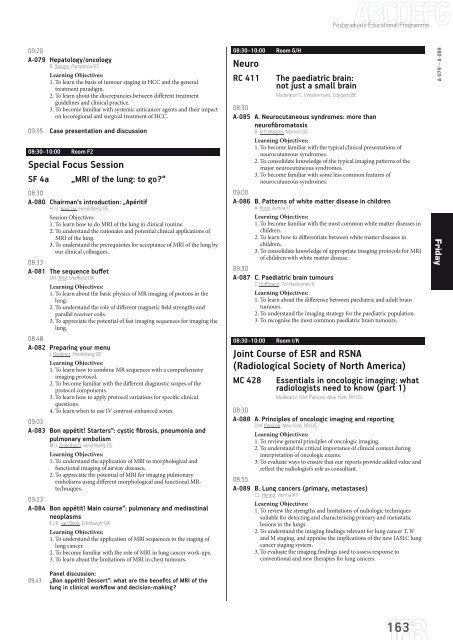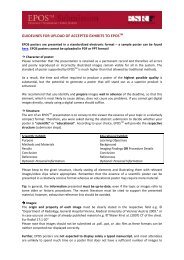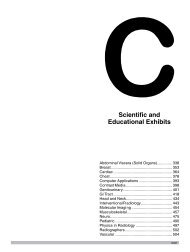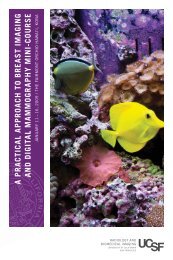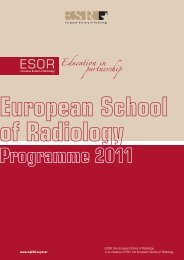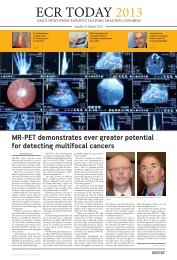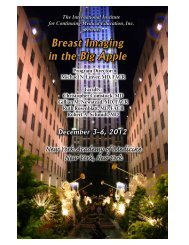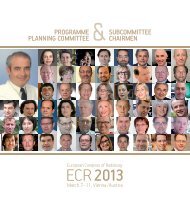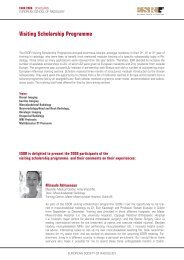ECR 2013 â Final Programme - myESR.org
ECR 2013 â Final Programme - myESR.org
ECR 2013 â Final Programme - myESR.org
- No tags were found...
Create successful ePaper yourself
Turn your PDF publications into a flip-book with our unique Google optimized e-Paper software.
Postgraduate Educational <strong>Programme</strong>09:20A-079 Hepatology/oncologyB. Sangro; Pamplona/ESLearning Objectives:1. To learn the basis of tumour staging in HCC and the generaltreatment paradigm.2. To learn about the discrepancies between different treatmentguidelines and clinical practice.3. To become familiar with systemic anticancer agents and their impacton locoregional and surgical treatment of HCC.09:35 Case presentation and discussion08:30–10:00 Room F2Special Focus SessionSF 4a „MRI of the lung: to go?“08:30A-080 Chairman‘s introduction: „ApéritifH.-U. Kauczor; Heidelberg/DESession Objectives:1. To learn how to do MRI of the lung in clinical routine.2. To understand the rationales and potential clinical applications ofMRI of the lung.3. To understand the prerequisites for acceptance of MRI of the lung byour clinical colleagues.08:33A-081 The sequence buffetJ.M. Wild; Sheffield/UKLearning Objectives:1. To learn about the basic physics of MR imaging of protons in thelung.2. To understand the role of different magnetic field strengths andparallel receiver coils.3. To appreciate the potential of fast imaging sequences for imaging thelung.08:48A-082 Preparing your menuJ. Biederer; Heidelberg/DELearning Objectives:1. To learn how to combine MR sequences with a comprehensiveimaging protocol.2. To become familiar with the different diagnostic scopes of theprotocol components.3. To learn how to apply protocol variations for specific clinicalquestions.4. To learn when to use IV contrast-enhanced series.09:03A-083 Bon appétit! Starters“: cystic fibrosis, pneumonia andpulmonary embolismM.U. Puderbach; Heidelberg/DELearning Objectives:1. To understand the application of MRI to morphological andfunctional imaging of airway diseases.2. To appreciate the potential of MRI for imaging pulmonaryembolisms using different morphological and functional MRtechniques.09:23A-084 Bon appétit! Main course“: pulmonary and mediastinalneoplasmsE.J.R. van Beek; Edinburgh/UKLearning Objectives:1. To understand the application of MRI sequences to the staging oflung cancer.2. To become familiar with the role of MRI in lung cancer work-ups.3. To learn about the limitations of MRI in chest tumours.08:30–10:00 Room G/HNeuroRC 411The paediatric brain:not just a small brainModerator: C. Venstermans; Edegem/BE08:30A-085 A. Neurocutaneous syndromes: more thanneurofibromatosisB. Ertl-Wagner; Munich/DELearning Objectives:1. To become familiar with the typical clinical presentations ofneurocutaneous syndromes.2. To consolidate knowledge of the typical imaging patterns of themajor neurocutaneous syndromes.3. To become familiar with some less common features ofneurocutaneous syndromes.09:00A-086 B. Patterns of white matter disease in childrenA. Rossi; Genoa/ITLearning Objectives:1. To become familiar with the most common white matter diseases inchildren.2. To learn how to differentiate between white matter diseases inchildren.3. To consolidate knowledge of appropriate imaging protocols for MRIof children with white matter disease.09:30A-087 C. Paediatric brain tumoursC. Hoffmann; Tel Hashomer/ILLearning Objectives:1. To learn about the difference between paediatric and adult braintumours.2. To understand the imaging strategy for the paediatric population.3. To recognise the most common paediatric brain tumours.08:30–10:00 Room I/KJoint Course of ESR and RSNA(Radiological Society of North America)MC 428 Essentials in oncologic imaging: whatradiologists need to know (part 1)Moderator: D.M. Panicek; New York, NY/US08:30A-088 A. Principles of oncologic imaging and reportingD.M. Panicek; New York, NY/USLearning Objectives:1. To review general principles of oncologic imaging.2. To understand the critical importance of clinical context duringinterpretation of oncologic exams.3. To evaluate ways to ensure that our reports provide added value andreflect the radiologist’s role as consultant.08:55A-089 B. Lung cancers (primary, metastases)C.J. Herold; Vienna/ATLearning Objectives:1. To review the strengths and limitations of radiologic techniquessuitable for detecting and characterising primary and metastaticlesions in the lungs.2. To understand the imaging findings relevant for lung cancer T, Nand M staging, and appraise the implications of the new IASLC lungcancer staging system.3. To evaluate the imaging findings used to assess response toconventional and new therapies for lung cancers.A-079 – A-089FridayPanel discussion:09:43 „Bon appétit! Dessert“: what are the benefits of MRI of thelung in clinical workflow and decision-making?163


